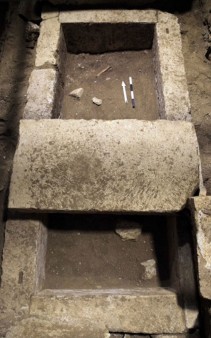The Dr. If. Papathanassiou speaks to Ana-MPA
"In and out of the grave, found the skeleton of a dead. It is obvious that the anthropological material will be examined by specialists. Is, equally, obvious that all investigations will be made which requires modern science». With these words, the announcement of the Ministry of culture and sport, informed the new, very important findings from Amphipolis and the excavations carried out by the Ephorate of Antiquities of Serres in Kasta namely Hill in the third Chamber of the monument. Ποιοι όμως είναι αυτοί οι ειδικοί επιστήμονες που εξετάζουν το ανθρωπολογικό υλικό, what stages it passes such a study, and what conclusions can be drawn;
"The physical (or biological) anthropology is a branch of anthropology to the study of natural (or biological) residue of human osteologikwn. Subdivision of the bioarchaiologia is that its purpose is the interdisciplinary study of anthropological remains of modern man (homo sapiens) within the framework of their cultural archaeological, "says Ana-MPA Dr Anastasia Papathanasiou, archaeologist of the Inspectorate Paleoanthropology and Paleontology, specializing in bioarchaiologia.
The bioarchaiologoi certainly have plenty to give to excavations with anthropological findings, like those of Amphipolis. "The study of human bone provides a range of information regarding both the cause of death and the way of life of a particular man and an entire population" says Ms. Papathanasiou. Among these are the sex, the age, some particular morphological elements, the height, possible diseases and injuries, the standard of living, eating habits, movement from one area to another.
However, in order to assess these elements, account should be taken of a number of macroscopic, microscopic and chemical analysis. But before all you need to become a proper fix. ' Before anaskafoyn bones, It is important that reflected their position inside the Tomb. In this way we understand if they are disturbed or if it is in the anatomical position, If you are going for removal or primary burial. Also, you will need to know the position of the bones and other artifacts. It is different to find a vase at some point inside the Tomb, another over the dead and another in the foot. It is a lot of information from the first fix. It is also very important in an excavation can be found bones, as in graves, from the outset there is a specialist in human bones» bioarchaiologos says.
After cleaning the bones, the second step is the macroscopic study. "I.e. to determine sex, the age, the stature and if there are pathological changes. Likely be able to see the cause of death, the stress which maybe passed during his lifetime, Some morphological characteristics and, in particular, information that the person, the height of the, anything can be comments from the bones and teeth ' mentions and complements that a tiny and radiographic study may give additional data on injuries, fractures, tumors, mikrotribes teeth, bone density etc..
The third stage is the chemical analyses, with the radiocarbon dating with carbon 14 comes first, as it can identify chronologiseis artifacts with very small error range. "This is the first thing that must be done, especially when there are questions about dating a finding and if we know that the bones be undisturbed, IE not have transferred from elsewhere. The next step is the analysis with stable isotopes, as carbon, nitrogen, sulfur and strontium that give valuable information about nutrition and mobility of people of the past "notes Ms. Papathanasiou. Adds: "The isotopes generally are based on the principle that you get from your environment that gives. For example, the teeth are only created in childhood, but bones updated continuously, so if there are differences in the teeth of the bones, It means that something changed in the life of, some different diet or move. Depending on the isotope that count each time».
As for the possibility of determination of DNA, Ms. Papathanasiou notes that it "may determine sibling relationships or specific genetic diseases. But another modern DNA, that's easy to isolations, another ancient and mainly the nuclear, in which there is a lot of cross-contamination. Also can not saved enough quantity of collagen, so it is possible to become radioactive carbon dating to be safe or stable isotopes. In the case of course of historical times might find all this, unless the conditions of the soil is very poor or is burnt bones, where the going gets tough. Generally the preserve plays a very big role "explains, Stressing that every hardware and location varies on storage conditions and is purely at the discretion of each excavator the methodology to be followed. End, with regard to the time needed to draw conclusions, This depends on the workshop and the workload may have and can range from a few weeks to a few months.







